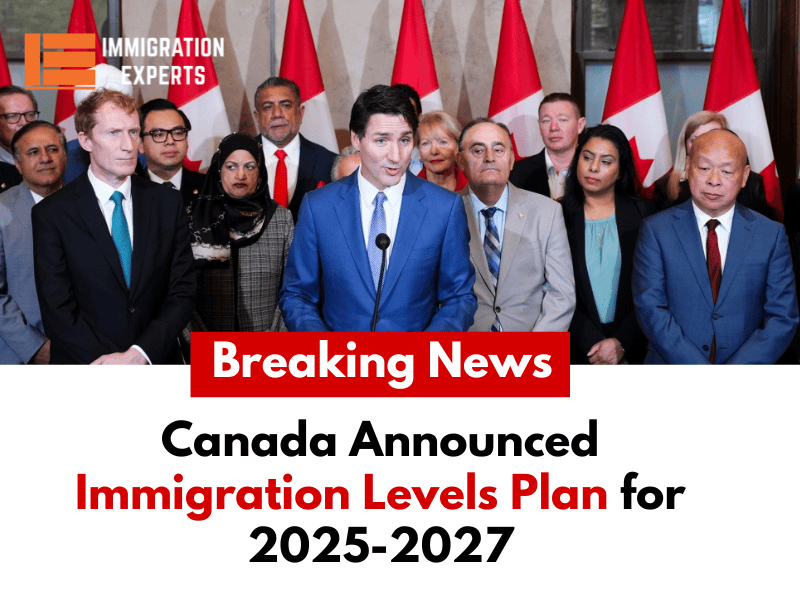051 8439995, 042 35911332

The Canadian government has recently released its Immigration Levels Plan for 2025-2027, establishing new goals for both Permanent Residents and Temporary Residents. This plan includes specific targets aimed at welcoming international students and foreign workers.
Canada has set a goal to welcome 2,873,850 immigrants, both permanent and temporary residents, as part of its commitment to supporting immigration. Immigration remains a vital component of Canada’s economy, and the Levels Plan has been developed carefully considering the country’s labor market demands.
Key Permanent Resident Targets
Each year, Immigration, Refugees, and Citizenship Canada (IRCC) unveils its Immigration Levels Plan, setting updated targets to stimulate economic growth. According to the latest plan, Canada aims to welcome:
| Year | Target for New Permanent Residents |
| 2025 | 395,000 |
| 2026 | 380,000 |
| 2027 | 365,000 |
Most permanent residents are expected to come to Canada through programs like Express Entry and the Provincial Nominee Program. Economic-class immigration continues to make up the largest share in the Levels Plan, followed by family reunification and humanitarian categories.
Economic Class: This category forms the majority of permanent residents, projected to account for almost 62% of all PR admissions by 2027.
Family Reunification: Approximately 184,300 immigrants, or 22% of the total PR targets, will be invited under family reunification programs.
Humanitarian Immigration: Canada aims to admit 68,350 immigrants in this category in 2025, with a target of 58,650 by 2027.
French-Speaking Admissions Outside Quebec: French-speaking PR admissions are set to make up 8.5% of the total PR intake in 2025, rising to 9.5% in 2026 and 10% in 2027.
Here is the table summarizing Canada’s immigration targets for 2025 to 2027 by immigration class:
| Immigration Class | 2025 | 2026 | 2027 |
| Economic | 232,150 | 229,750 | 225,350 |
| Family | 94,500 | 88,000 | 81,000 |
| Refugees, Protected Persons, Humanitarian, Compassionate, and Other | 68,350 | 62,250 | 58,650 |
| French-speaking Admissions Outside of Quebec | 29,325 | 31,350 | 31,350 |
| Total | 395,000 | 380,000 | 365,000 |

Canada’s Immigration Levels Plan 2025-2027 for Permanent Residents
| Immigrant Category | 2025 | 2026 | 2027 |
| Overall Planned Permanent Resident Admissions | 395,000 | 380,000 | 365,000 |
| Economic | |||
| Federal Economic Priorities | 41,700 | 47,400 | 47,800 |
| In-Canada Focus | 82,980 | 75,830 | 70,930 |
| Federal Business | 2,000 | 1,000 | 1,000 |
| Economic Pilots: Caregivers, Agri-Food, Economic Mobility Pathways | 10,920 | 9,920 | 9,920 |
| Atlantic Immigration Program | 5,000 | 5,000 | 5,000 |
| Provincial Nominee Program | 55,000 | 55,000 | 55,000 |
| Quebec Skilled Workers and Business | 34,500 | To be determined | To be determined |
| Regularization Public Policy | 50 | 100 | 200 |
| Total Economic | 232,150 | 229,750 | 225,350 |
| Family | |||
| Spouses, Partners, and Children | 70,000 | 66,500 | 61,000 |
| Parents and Grandparents | 24,500 | 21,500 | 20,000 |
| Total Family | 94,500 | 88,000 | 81,000 |
| Refugees and Protected Persons | |||
| Protected Persons in Canada and Dependents Abroad | 20,000 | 18,000 | 18,000 |
| Resettled Refugees – Government-Assisted | 15,250 | 15,250 | 15,250 |
| Resettled Refugees – Privately Sponsored | 23,000 | 22,000 | 21,000 |
| Resettled Refugees – Blended Visa Office-Referred | 100 | 100 | 100 |
| Total Refugees and Protected Persons | 58,350 | 55,350 | 54,350 |
| Humanitarian and Other | |||
| Total Humanitarian & Compassionate and Other | 10,000 | 6,900 | 4,300 |
| Francophone Permanent Resident Immigration outside of Quebec | 29,325 | 31,350 | 31,500 |
Immigration Levels Plan 2025-2027 for Temporary Residents
Here’s the table summarizing the Temporary Resident Levels for 2025-2027:
| Temporary Resident Program | 2025 | 2026 | 2027 |
| Overall Levels | 673,650 | 516,600 | 543,600 |
| Workers (Total) | 367,750 | 210,700 | 237,700 |
| International Mobility Program (IMP) | 285,750 | 128,700 | 155,700 |
| Temporary Foreign Worker Program (TFWP) | 82,000 | 82,000 | 82,000 |
| Students | 305,900 | 305,900 | 305,900 |
The Importance of Immigration for Canada’s Economic Future
Canada’s economy relies heavily on immigration to sustain growth and meet labor market demands. With one of the oldest populations globally and one of the lowest birth rates, Canada faces economic challenges as natural population growth continues to decline. This trend restricts workforce expansion and slows economic progress, making it difficult to generate sufficient tax revenue for essential services like education, healthcare, and social programs that uphold the country’s quality of life.
To tackle these issues, Canada has increased immigration levels steadily since the late 1980s, aiming to boost population numbers, workforce size, and economic growth. Today, immigration drives most of Canada’s population and labor force growth and has become a core element of its economic strategy.
In the coming years, the importance of immigration will grow even more. By 2030, nearly 9 million baby boomers will reach retirement age, reducing the working-age population as healthcare and social program costs rise. Recognizing this, Canada has proactively raised immigration targets for over 30 years, welcoming over 200,000 newcomers each year since 1988.
Currently, Canada’s immigration rate stands at about 1.2%, bringing in three times as many immigrants per capita as the United States. This consistent approach to immigration is vital for Canada’s economic strength and fiscal health.
To understand Canadian immigration system better, click on the link for a comprehensive guide.
